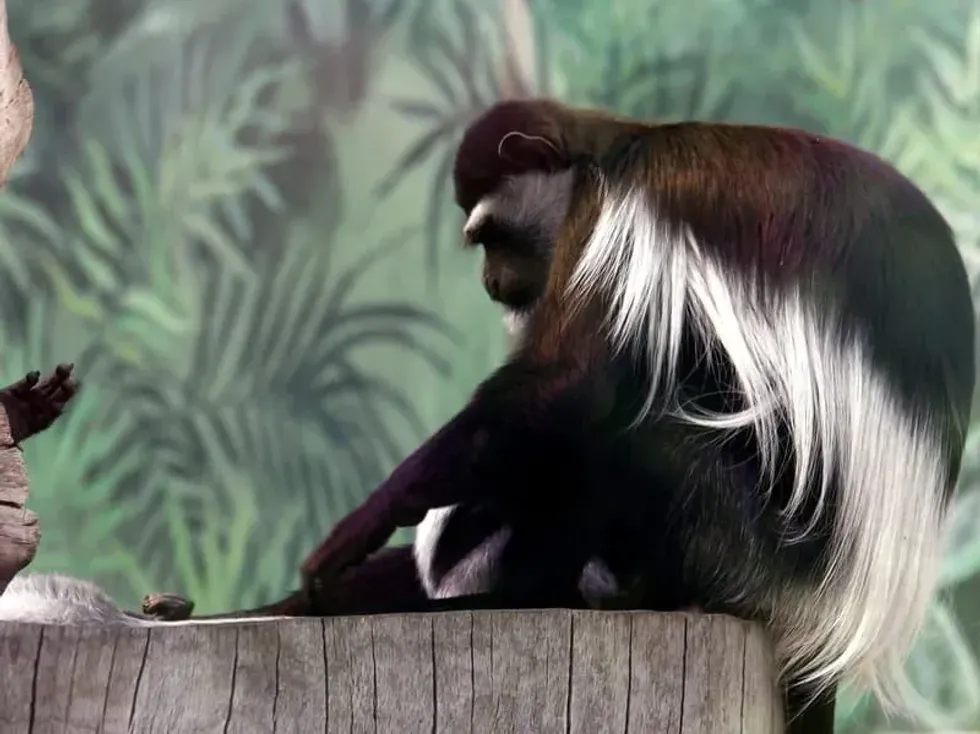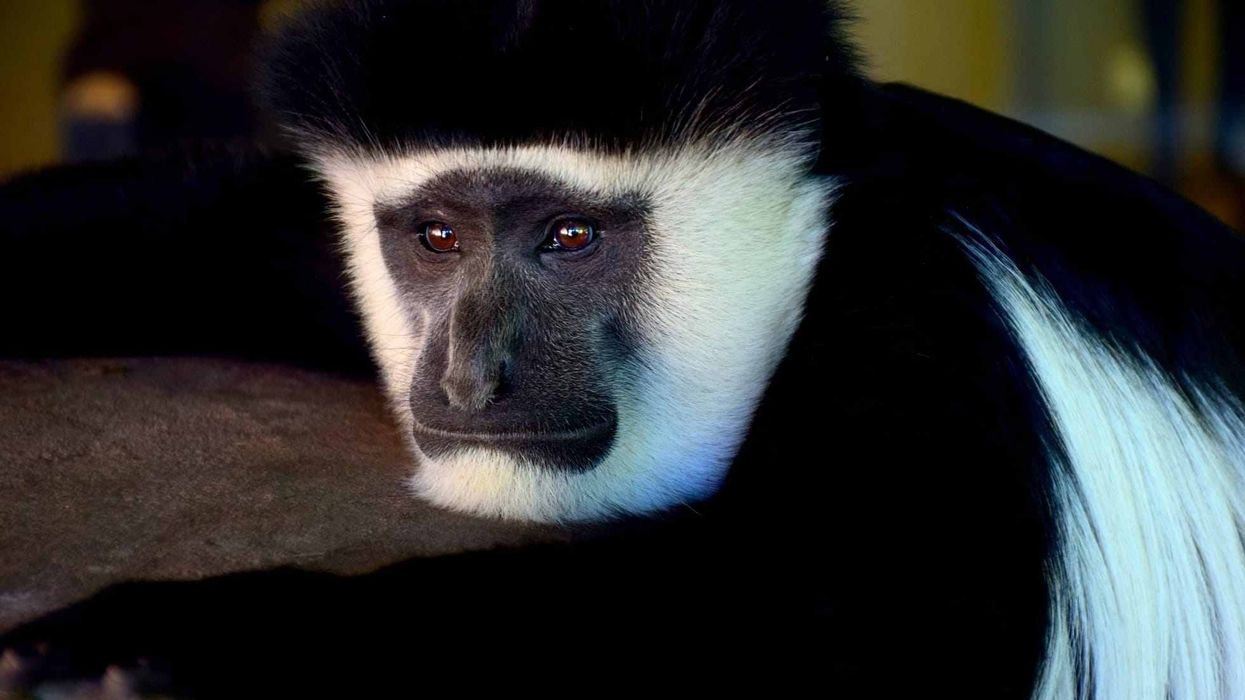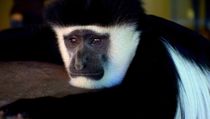Fun Mantled Guereza Facts For Kids
Mantled guerezas, also simply called guerezas are Old World monkeys native to many parts of Africa. They are most abundant in the equatorial countries of Africa such as Nigeria, Kenya, Cameroon, Uganda, Ethiopia, and Tanzania.
Their most preferred habitats are rainforests and woodlands. Their chief food source is leaves bark, wood, fruits, seeds, and sometimes arthropods.
They face predatory threats from birds of prey, leopards, and sometimes even chimpanzees.
They are territorial creatures with social structures. The most recognizable feature of mantled guerezas is the white, fringe fur that hangs off the sides of their bodies and their tails.
Their overall coloration is black and white which is why they are also called eastern black and white colobuses and Abyssinian black and white colobuses. Even though they are a species of Least Concern as per the IUCN, their numbers have faced significant declines due to habitat degradation, fur and meat trading, and experimentation by humans.
For more relatable content, check out these langur monkey facts and woolly monkey facts for kids.
Mantled Guereza Interesting Facts
What type of animal is a mantled guereza?
The mantled guereza (Colobus guereza) is an Old World monkey.
What class of animal does a mantled guereza belong to?
The mantled Guereza (Colobus guereza) belongs to the Mammalia class of animals.
How many mantled guerezas are there in the world?
It is not known how many mantled guerezas are currently alive since they are widespread and locally abundant and dense in many parts of their habitat.
Where does a mantled guereza live?
Mantled guerezas (or eastern black-and-white colobus monkeys) are mostly found in the equatorial countries of Africa. Their geographic range includes Nigeria, Cameroon, Kenya, Ethiopia, Uganda, and northern Tanzania.
This colobus monkey species is also found near the upper Donga river and its tributaries, and in both the west and east sides of the river Niger. Other places these guerezas are native to include Gashaka, Gojjam, Ngelnyaki, Kulla, north Congo, east Gabon, Central African Republic, western Kenya, northeast Zaire, northwest Rwanda, and South Sudan.
What is a mantled guereza's habitat?
Mantled guerezas (eastern black-and-white colobus monkeys) are mostly seen in tropical rainforests, savannah woodlands, lowlands, highlands, and montane forests. This colobus monkey species lives in both evergreen and deciduous forests. These guerezas also inhabit secondary and primary forests, galleries, upland, and riparian forests.
They favor secondary forests rather than old-growth forests. Lands close to brackish and freshwater bodies like lakes and rivers are preferred. Mantled guerezas can be found at elevations of 10,827 ft (3,300 m).
Who do mantled guerezas live with?
Mantled guerezas (or eastern black-and-white colobus monkeys) live in groups of 8-15 individuals. This group has one adult male and three to four adult females and the rest are infants and adolescents.
Some groups have multiple but only temporary males. Females stay in the group for their entire lives and they have their own friendly relationships and are seen grooming one another and even taking care of each other kids, even suckling them.
Younger male monkeys leave a group before becoming adults, voluntarily or by force. They become solitary after this or temporarily live with other males who are also solitary.
Some of these male guerezas make their own groups and harems. Strong male monkeys take on leadership roles. Infanticide has also been observed where male infants are born to quell the threat of replacements.
Mantled guerezas do not form friendly intergroup relationships and they can be very territorial too. Their territories are properly defined and as big as 32-40 acres (0.13-0.16 sq.
km). Male guerezas are vigorous defenders of these territories and are known to leap, cry, fight, roar, and chase intruders. There may be sharing of water bodies and resources amongst different groups sometimes.
How long does a mantled guereza live?
Mantled guerezas (or eastern black-and-white colobus monkeys) live for 20 years in the wild. Their captive life span is close to 29 years.
How do they reproduce?
Mantled guerezas reproduce by mating giving birth to live offspring. They tend to have a polygynous mating system.
There is no particular breeding season. Certain times of the year have peaks in the birth of infants but this is due to the availability of ample food. Males become mature after they're six years old and females become mature after they are four years old.
The gestation period lasts for six months and females give birth after every 20 months. Females of the group are the ones to initiate sexual behavior by tongue smacking.
Newborn infants weigh close to 14.1 oz (0.4 kg) and have a head-body length of 7.9 in (20 cm). They tend to cling to their parent's stomachs and their eyes are open. The child receives parental care from both parents. Also, since females stay in the same group all their lives, the daughters and mothers have lifelong bonds.
What is their conservation status?
The conservation status of the mantled guereza (Colobus guereza) species according to the International Union for Conservation of Nature is Least Concern.
Mantled Guereza Fun Facts
What do mantled guerezas look like?
The most noteworthy feature of the mantled guerezas (or eastern black-and-white colobus monkeys) is that they have long white strands of silky hair extending from the body and tail.
Mantled guerezas have heavy bodies and long tails. Males weigh a little more than females. The mantled guereza hands have no thumb and there are only four digits.
They instead have a phalangeal tubercle that may have a nail. They do not have cheek pouches but have noticeable ischial callosities. These callosities are separated in females and together in males.
The fur of the mantled guerezas is glossy black and white. They have gray, furless faces that are surrounded by white hair or fur. The callosities are also bordered by white.
On the sides are the U-shaped mantles of different lengths that are also white in color. The tails can be yellowish or whitish from base to tip and the outside areas of the thighs are also a variable white. The end of the tail also has a big white tuft.
The lower jaw protrudes beyond the upper jaw. The orbits of the skull are oval and small and have narrow superciliary ridges.
The side of the skull also has a postorbital bar that forms a plate and separates the temporal fossa from the orbit. The nose almost touches the mouth and the nostrils appear lengthened due to the extended nasal skin.
The molar teeth of mantled guerezas have cusps that are high and pointed. The lower molars are more or less convexly buttressed. The lower incisors have thick enamel on the inside and the second incisor on the lower side has a lateral process.
The young guerezas lack the defined black and white colors of the adults. They are instead a pure white color for the initial weeks of their lives.

How cute are they?
Mantled guerezas are beautiful monkeys. The extended white fur from their sides (mantles) makes them look like mysterious, macabre creatures. The black and white coloration of this colobus monkey species is very pleasing to look at. These guerezas also have emotive and well-defined faces that lend a sage-like quality to their appearance. They also have gorgeous and fringy tails.
How do they communicate?
Mantled guerezas communicate mainly through vocal, visual, and tactile means. They are known to roar loudly in territorial choruses at dawn and at night. The different sounds they make are roars, purrs, honks, snorts, and screams.
To show aggression, they flap their fringe white fur up and down. They also use visual signals such as different expressions and body postures. Mantled guerezas also use playing and grooming as a means of tactile communication.
How big is a mantled guereza?
Mantled guerezas are 17.7-28.4 in (45-72 cm) long from the head to the end of the body and their tails are 20.5-39.4 in (52-100 cm) long. This makes them four to seven times bigger than pygmy marmosets and twice as big as squirrel monkeys.
How fast can a mantled guereza move?
The exact speeds with which mantled guerezas move are unclear but their thumbless hands allow them to move quickly through the trees.
How much does a mantled guereza weigh?
A mantled guereza may weigh 11-30.9 lb (5-14 kg).
What are the male and female names of the species?
There are no specific names for males and females of the mantled guereza species.
What would you call a baby mantled guereza?
A baby mantled guereza would be called an infant.
What do they eat?
Mantled guerezas eat leaves, vegetables, fruit, bark, seeds, wood, petioles, flowers, aquatic plants, lianas, soil, and arthropods. They also eat monkey chow in captivity.
They themselves get preyed upon by leopards and birds of prey such as the crowned eagle (or the crowned hawk-eagle) and the Verreaux's eagle among others. Chimpanzees also prey on mantled guerezas sometimes.
Are they active?
Yes, mantled guerezas are active monkeys. They are diurnal, foraging in the daytime on the ground or on trees and resting at night. At least one monkey in a group is active at night and they take turns sleeping to watch out for predators.
Would they make a good pet?
No, mantled guerezas would not make good pets. They are wild animals who live in complex social structures. They do face many threats from humans, however.
The mantled guerezas are often used for testing cures for human diseases and their behavior and physiology are also studied. Their rich silky fur is considered luxurious in some cultures and they are exploited in great numbers by various trades and companies. Also, mantled guerezas do not initiate contact with people if they are close.
Did you know...
Colobus monkeys are largely herbivores and the different species eat seeds, leaves, fruits, and flowers. Things like termite clay, arthropods, insects may be added to the diet rarely.
The white-thighed colobus or the Ursine colobus is Critically Endangered with only 975 mature individuals remaining and its population shows a declining trend. The black colobus and the Angolan colobus are both Endangered and their population shows a declining trend too.
The king colobus is Endangered with a declining population. The primate species of Colobus monkeys are Endangered because of exploitation due to fur and meat trading, habitat destruction, and human experimentation.
Black and white monkeys belong to the Colobus genus of Old World monkeys. They are called Colobus monkeys.
None of the Colobus monkeys have thumbs.
Why is the mantled guereza endangered?
As per the IUCN, mantled guerezas are a species of Least Concern and not Endangered.
However, over the course of the last 100 years, populations of mantled guerezas have declined drastically. This is due to deforestation and hunting.
The meat of mantled guerezas is also sold as bushmeat for as low as $4-$9. There is a danger of mantled guereza extinction if the skin and fur exploitation is not stopped. These Old World monkeys have also endured because they can adapt to degraded habitats and forests.
Do mantled guerezas have thumbs?
No, mantled guerezas famously do not have thumbs. It is believed this is an evolutionary development that enables this colobus monkey species to move through the trees quicker. Even the scientific name 'Colobus' comes from the Greek word 'kolobus' which means 'mutilated', a clear reference to the absence of thumbs in this species.
Here at Kidadl, we have carefully created lots of interesting family-friendly animal facts for everyone to discover! For more relatable content, check out these patas monkey facts and cotton-top tamarin fun facts pages.
You can even occupy yourself at home by coloring in one of our free printable Mantled guereza coloring pages.
We Want Your Photos!
More for You
See All
Bachelor of Arts specializing in Linguistics

Martha MartinsBachelor of Arts specializing in Linguistics
Martha is a full-time creative writer, content strategist, and aspiring screenwriter who communicates complex thoughts and ideas effectively. She has completed her Bachelor's in Linguistics from Nasarawa State University. As an enthusiast of public relations and communication, Martha is well-prepared to substantially impact your organization as your next content writer and strategist. Her dedication to her craft and commitment to delivering high-quality work enables her to create compelling content that resonates with audiences.
Disclaimer
1) Kidadl is independent and to make our service free to you the reader we are supported by advertising. We hope you love our recommendations for products and services! What we suggest is selected independently by the Kidadl team. If you purchase using the Buy Now button we may earn a small commission. This does not influence our choices. Prices are correct and items are available at the time the article was published but we cannot guarantee that on the time of reading. Please note that Kidadl is a participant in the Amazon Services LLC Associates Program, an affiliate advertising program designed to provide a means for sites to earn advertising fees by advertising and linking to Amazon. We also link to other websites, but are not responsible for their content.
2) At Kidadl, we strive to recommend the very best activities and events. We will always aim to give you accurate information at the date of publication - however, information does change, so it’s important you do your own research, double-check and make the decision that is right for your family. We recognise that not all activities and ideas are appropriate for all children and families or in all circumstances. Our recommended activities are based on age but these are a guide. We recommend that these ideas are used as inspiration, that ideas are undertaken with appropriate adult supervision, and that each adult uses their own discretion and knowledge of their children to consider the safety and suitability. Kidadl cannot accept liability for the execution of these ideas, and parental supervision is advised at all times, as safety is paramount. Anyone using the information provided by Kidadl does so at their own risk and we can not accept liability if things go wrong.
3) Because we are an educational resource, we have quotes and facts about a range of historical and modern figures. We do not endorse the actions of or rhetoric of all the people included in these collections, but we think they are important for growing minds to learn about under the guidance of parents or guardians.







